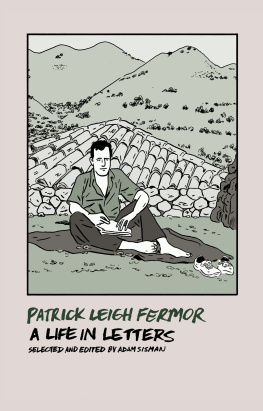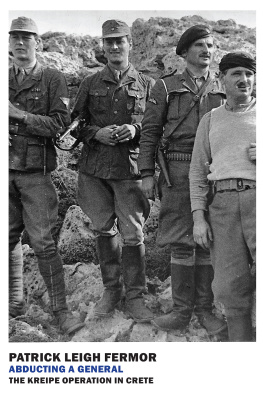AUTHORS INTRODUCTION
A S THE reader may gather from occasional hints in the following pages, I was hindered by several disabilities from sharing to the utmost all the advantages a stranger may gain from monastic sojourns. Hints they must remain as they touch on perplexities that have little bearing on the main drift of this book; but it is worth mentioning them in order to make it clear that there are serious limitations to my authority in writing of these matters, and to prepare the reader for the shortcomings attendant on incomplete knowledge and experience.
But, in spite of these private limitations I was profoundly affected by the places I have described. I am not sure what these feelings amount to, but they are deeper than mere interest and curiosity, and more important than the pleasure an historian or an sthete finds in ancient buildings and liturgy; for I could have seen the former in many places and the latterthough seldom, perhaps, as well performed as at St. Wandrille or SolesmesI had always known.
The kindness of the monks has something to do with this. But more important was the discovery of a capacity for solitude and (on however humble a level compared to that of most people who resort to monasteries) for the recollectedness and clarity of spirit that accompany the silent monastic life. For, in the seclusion of a cellan existence whose quietness is only varied by the silent meals, the solemnity of ritual and long solitary walks in the woodsthe troubled waters of the mind grow still and clear, and much that is hidden away and all that clouds it floats to the surface and can be skimmed away; and after a time one reaches a state of peace that is unthought of in the ordinary world. This is so different from any normal experience, that it makes the stranger suspect that he has been the beneficiary (in spite, or in the teeth, of recalcitrance or scepticism or plain incapacity for belief) of a supernatural windfall or an unconsciously appropriated share in the spiritual activity that is always at work in monasteries. Even someone like myselfno stranger to the disabilities I have just mentionedwhen thrown by chance in touch with monasticism, can glean from it much of the healing and mysterious enchantment for which, among other purposes, monasteries were built.
It is impossible for anyone who has had even this slight experience not to feel, at the sight of empty monasteries, a sorrow sharper than the regret of an antiquarian. Something of this elegiac sadness overhangs the rock-monasteries of Cappadocia that I have tried to describe. But, for us in the West, because of all such relics they are the most compelling mementoes of the life that once animated them, the ruined abbeys of England that have remained desolate since the Reformation will always be the most moving and tragic. For there is no riddle here. We know the function and purpose of every fragment and the exact details of the holy life that should be sheltering there. We know, too, the miserable and wanton story of their destruction and their dereliction, and have only to close our eyes for a second for the imagination to rebuild the towers and the pinnacles and summon to our ears the quiet rumour of monkish activity and the sound of bells melted long ago. They emerge in the fields like the peaks of a vanished Atlantis drowned four centuries deep. The gutted cloisters stand uselessly among the furrows and only broken pillars mark the former symmetry of the aisles and ambulatories. Surrounded by elder-flower, with their bases entangled in bracken and blackberry and bridged at their summits with arches and broken spandrels that fly spinning over the tree-tops in slender trajectories, the clustering pillars suspend the great empty circumference of a rose-window in the rook-haunted sky. It is as though some tremendous Gregorian chant had been interrupted hundreds of years ago to hang there petrified at its climax ever since.
P.L.F.
1957
* * *
It is hard to believe that these monastic travels and halts took place thirty years ago. Asked point blank, I would have said: ten at the outside, for they remain clearer in detail than some later tracts of life that have been blurred or swept away.
I have seen a number of monasteries in the interim: La Pierre qui Vire, St. Benot-sur-Loire, Fossanova, Trisulti, Monte Olivetto, Subiaco, the ruins of Monte Cassino, the Charterhouses of Pavia and Jerez, Guadalupe and Yuste, Beuron, Gottweig and Melk, The Merced of Cuzco, Santa Catalina at Arequipa in Peru, the familiar monasteries of Greece and those very early Arabic- and Aramaic-speaking foundations among the canyons near Damascus. But these were a part of wider travels. The only ones where, at wide intervals, I have made sojourns like the ones I have tried to describe have been at St. Wandrille and Quarr Abbey. Each time they seem surer abodes of faith, wisdom, learning, goodness and dignified and scrupulous observance, and much survives in places like these which otherwise have vanished or changed. Listening to the singing of the Hours in the language of fifth- or sixth-century Western Christendom, one can forget the alterations of the twentieth and feel that the life-line of notes and syllables between the Early Church and today is still intact: that these, indeed, might have been the sung words to which King Aethelbert and Queen Bertha listened when St. Augustine first set foot in the Isle of Thanet.
When it first came out, the book struck lucky with reviewers and with readers outside monasteries, andinsofar as I could tell, which is not muchinside as well. But one monastic critic brought it rather sternly to task: I had picked up a superficial acquaintance with monastic matters while staying as a guest; to write about them was intrusive and indiscreet. It was an aspect which had not struck me as it ought to have done, but I saw at once and all too clearly what he meant. I was very downcast and I wrote to the same periodical with a rather clumsy apology; and this, soon afterwards, evoked a letter from a monk whom I had not met. Without contradicting any of the strictures, he inferred, with great tact and kindness, that his colleague had been severe in this instance and that the innocent intention was clear.
The book was basedwhole passages of it word for wordon letters I wrote at the time to a correspondent (whom I later married) without the remotest thought of publication. I was living a lot in France, much under the influence of Huysmans, and I haunted quays and bookshops and libraries. Starting with Montalemberts Les Moines dOccident , I read everything about monasticism and, above all, French monastic history that I could find. It was then that I thought of putting these months together in literary form; and when at last the text was in proof, I returned to St. Wandrille to show it to the Abbot. As the reader will see, I liked and admired him greatly; he was a scholarly, civilized and good man; I was anxious about his opinion; and the overall impression was encouraging. He liked the descriptive and historical parts about his Abbey to which he was deeply attached and there were mistakes that could be remedied. I said I must have gone off the rails sometimes. From the monks point of view, he said with a smile, of course you have! But these are the parts to me that make it interesting. I took these words as I hoped they were meant. As long as I made my own position clear, he said, he could see nothing against it.









